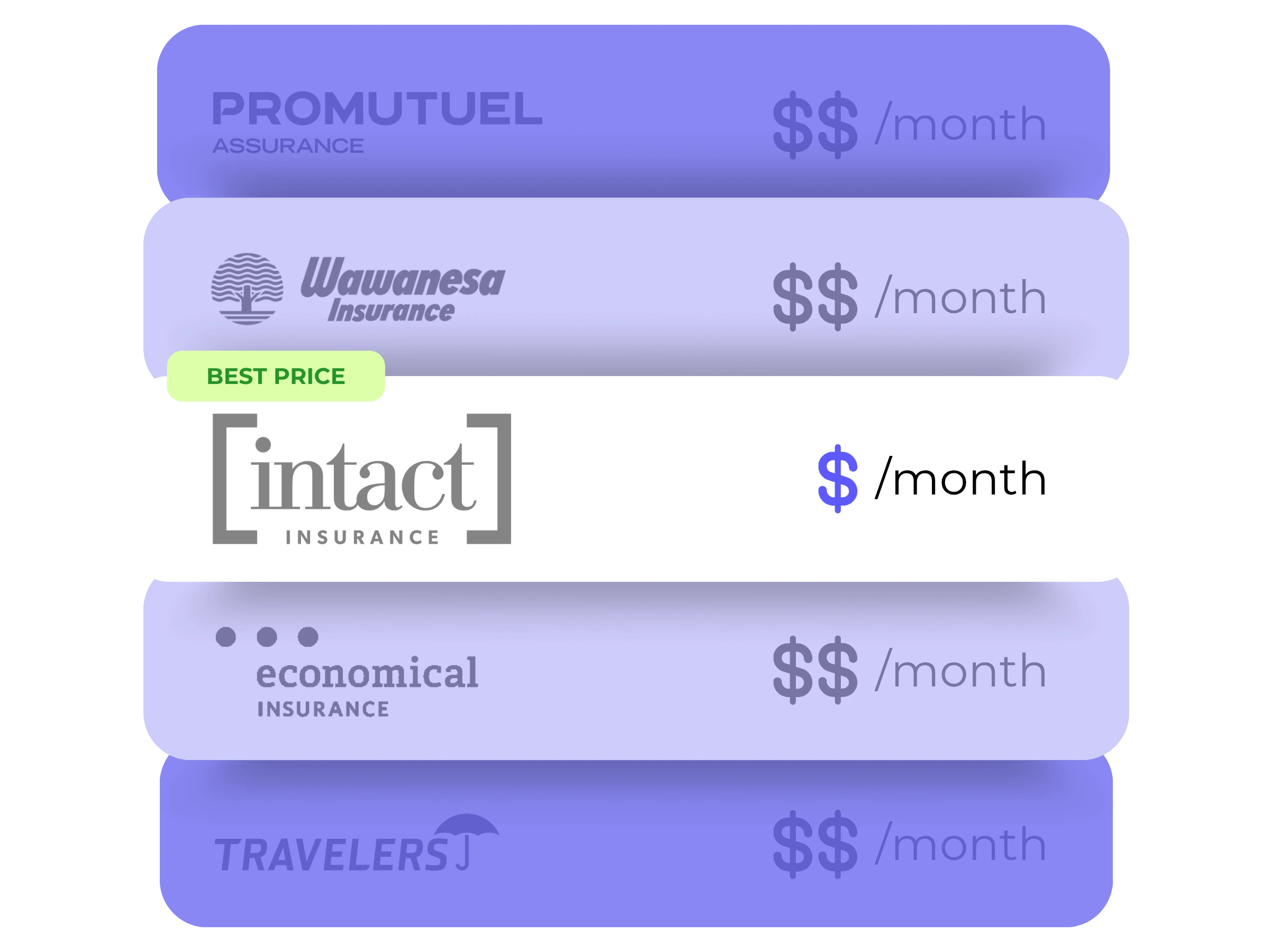Moving to Ontario from another province? Whether you’re relocating for work, school, or simply want to explore a new province, there’s a lot to keep track of. Moving to Ontario involves more than just packing up your bags; it also means changing your address, getting a new driver’s license, and securing home insurance.
In this blog, we’ll walk you through everything you need to do after moving to Ontario, step by step, so you can settle in with confidence and enjoy your new home.

What you need to do when moving to Ontario
If you’re a Canadian citizen or permanent resident, you’re free to live anywhere in Canada, including Ontario. Moving between provinces doesn’t require special permissions or paperwork, but there are a few important steps when relocating. Here’s what you need to do when moving to Ontario from another province:
- Confirm your move: Make sure Ontario is the right fit for your lifestyle and goals.
- Create a budget: Plan your finances to cover moving expenses, rent or deposits, and Ontario’s cost of living.
- Choose your new city or region: Decide whether you want to live in a big city like Toronto or Ottawa, or a smaller community.
- Confirm your employment: Secure a job or start your job search through Ontario-based listings and recruitment agencies.
- Plan your move: Pick a moving date, book transportation, and decide what items you’ll bring or leave.
- Update your ID and documents: Exchange your out-of-province driver’s license and vehicle registration at ServiceOntario.
- Apply for Ontario health insurance: Register for OHIP as soon as you move to access healthcare coverage.
- Set up utilities and internet: Arrange for electricity, gas, internet, and other utilities in your new home.
- Get home insurance: Purchase tenant, condo, or homeowners insurance, as landlords, condo associations, and mortgage lenders often require it.
- Update or buy car insurance: Ensure you have car insurance, which is mandatory in Ontario, from an insurance provider like YouSet.
Moving to Ontario from another province: To-do list
Whether you’re moving to a big city like Toronto or Ottawa or a smaller town, here’s a step-by-step checklist to make your transition as smooth and stress-free as possible.
✅ Sign your lease or finalize the purchase of your new home
Once you’ve decided to move to Ontario, the first step is securing a place to live. Whether you’re renting or buying, take some time to review your lease or purchase agreement carefully and ask questions before signing.
Once everything is official, you’ll have your new Ontario address!
✅ Create a moving budget
Moving can get expensive, so a solid budget will help keep things on track. Include costs like movers or truck rentals, gas, hotels, storage, travel costs, new furniture, and a buffer for unexpected expenses.
The cost of moving to Ontario from another province can vary, depending on:
- Whether you hire movers or DIY
- How far you’re travelling
- The time of year (summer months can be busy)
- The size and weight of your move.
For example, moving a small apartment from Montreal to Toronto yourself might cost between $1,000 and $2,000, while a full-service cross-country move could be over $7,000. A budget will help you stay financially prepared.
✅ Hire a moving company or rent a truck, if needed
Depending on your budget and how much stuff you’re bringing, you might want to book a moving truck or professional movers. Peak moving season is in the summer, so be sure to reserve early and compare quotes to get the best deal.
✅ If you’re driving your car to Ontario, plan your route
Driving to Ontario? Map your route ahead of time, including rest stops and overnight stays if needed. Make sure your car is ready for the trip with basic maintenance like tire and oil checks, and bring your driver’s license, vehicle registration, and proof of insurance.
✅ If you’re shipping your car to Ontario, contact a transport service
If driving isn’t an option, you can ship your car with a reliable transport company. Get a few quotes, check reviews, and confirm pickup and delivery dates so it lines up with your move.
Some well-rated car transport companies in Canada include:
- MVS Canada
- Canadian Car Shipping
- Professional Car Carriers
✅ Update your driver’s license
You can use an out-of-province driver’s license for up to 60 days in Ontario. After that, you’ll need to exchange it for an official Ontario driver’s license.
To make the switch, visit your local DriveTest centre or the ServiceOntario in downtown Toronto. When you arrive, here’s what you will need to do:
- Present your original, valid driver’s license
- Present originals of accepted identity documents
- Present original supporting documents showing proof of driving experience in English or French
- Take a vision test
- Pay applicable fees
- Fill out an application form
Depending on your circumstances, you might also need to take a knowledge or road test.
✅ Update your vehicle registration
If you have a vehicle, you have 30 days to register it at a ServiceOntario centre. Make sure you have proof of lease and fill out the Application for Vehicle Registration form.
Most vehicles purchased privately in another province will be charged retail sales tax or HST at 13% when you register in Ontario, so you’ll also need to pay that. However, if you’re becoming an Ontario resident, you may be able to declare an exemption when registering the vehicle instead of paying.
You’ll also need to:
- Get an Ontario vehicle permit and license plates
- Purchase car insurance from an Ontario provider
✅ Buy car insurance
Ontario doesn’t have a public car insurance plan like some other provinces, so it’s important you buy car insurance from a licensed provider like YouSet. In fact, it’s required by law that you do so. If you don’t, you may be fined up to $50,000.
At a minimum, you’ll need a policy that includes the following:
- Third-party liability coverage
- Statutory accident benefits coverage
- Direct compensation property damage coverage (it’s beneficial, although you can opt out)
- Uninsured automobile coverage
However, collision and comprehensive coverage are highly recommended—and sometimes even required if you’re leasing or financing your car.
✅ Buy insurance for your home, condo, or rental
Home insurance isn’t mandatory by law in Ontario, but landlords, condo associations, and mortgage lenders often require it. Even then, it’s always a smart move to get it because it covers your belongings, liability, and additional living expenses if something goes wrong in your new home, like a fire or break-in.
Fortunately, YouSet can help you compare multiple Ontario insurers and get the best price on tenant insurance, condo insurance, and homeowners insuranceyear-afer-year.
✅ Set up utilities for your new home
Ontario has multiple electricity providers, depending on your region. In most areas, Hydro One or your local hydro utility will be your go-to for power. For gas, Enbridge is the main supplier.
Set up accounts for electricity and gas (if needed) ahead of time to make sure everything’s running when you arrive.
If you’re setting up an account with Hydro One, you can do it easily online. After you move in, you’ll receive an account number within 10 business days. Once you have it, you can register online or over the phone.
Here’s how to sign up for hydro in Ontario with Hydro One online:
- Visit the Hydro One Request a Service page
- Select “Move In/Out or New Service”
- Choose the “Moving in – set up account” option
- Enter your details
✅ Apply for Ontario’s health insurance (OHIP)
Healthcare in Ontario is covered by the Ontario Health Insurance Plan (OHIP), and it’s free to apply. If you’re eligible, there’s no waiting period–your coverage starts right away.
To apply for OHIP, visit a ServiceOntario centre in person and bring the following documents with you:
- A completed Registration for Ontario Health Insurance Coverage form
- 3 documents that prove your Canadian citizenship or immigration status, residency in Ontario, and your identity
Once approved, you’ll receive your Ontario health card, which you’ll need to present every time you visit a doctor or hospital.
✅ Set up mail forwarding with Canada Post
Even if you update your address everywhere, some mail might not follow right away. Set up mail forwarding with Canada Post for at least 4 months after you move to avoid missing anything important.
While you can set up mail forwarding with Canada Post at a post office, it’s easy to do so online. Here’s how you can set it up:
- Log in to your Canada Post account or create one if you’re new
- Fill in your current and new address details
- Upload a valid piece of ID
- Choose how long you want the service to run (4 or 12 months)
- Enter your payment details.
Make sure to arrange mail forwarding before you move, as it takes about five days to activate the service.
✅ Choose an internet service provider and set up an account
If your current provider doesn’t operate in Ontario, you’ll need to switch. Compare internet plans based on speed, reliability, and price, and set up your account before moving day.
Once you’ve picked a provider, setting up your service is usually quick and easy. You can:
- Sign up online or call the provider to create your account
- Book an installation appointment (if needed)
- Receive your modem or router and complete the setup
Popular internet providers in Ontario include:
- Bell
- Rogers
- TekSavvy
- Distributel
- Start.ca
- Fido
- Virgin Plus
✅ Set up local municipal services
Depending on where you’re moving in Ontario, you may need to register with your new city or town for certain local services. These can include:
Garbage and recycling collection: Some municipalities require you to register your address or order bins to begin regular garbage, recycling, and green bin pickup.
Property taxes: If you’ve purchased a home, be sure to update your ownership information in the city to receive your property tax bills and set up a payment method.
Parking permits: In cities like Toronto, you may need to apply for a residential street parking permit if you plan to park on the street near your home. This can typically be done online through your city’s website.
Pet registration: Many cities in Ontario require you to get a license for your dog or cat. You can usually do this online.
Voter registration: Update your address with Elections Ontario to ensure you’re registered to vote in provincial and municipal elections. You can do this online or by mail.
✅ Update your banking information
Once you’ve settled in, don’t forget to update your address with your bank, credit cards, employer, and anywhere else important, especially anything tied to automatic payments or government benefits, to ensure you continue receiving them.



